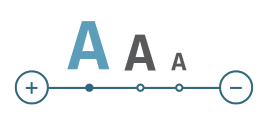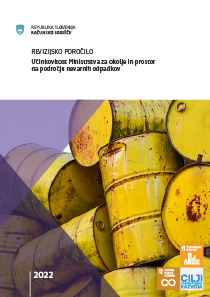The Court of Audit undertook the audit of the efficiency of operations of the Ministry of the Environment and Spatial Planning (hereinafter referred to as: Ministry) in hazardous waste prevention and management in the period from 1 January 2016 to 30 June 2021. The Court of Audit established that the Ministry was partially efficient.
Hazardous waste is waste with properties that make it dangerous (i.e. explosive, flammable, acute toxicity, carcinogen and other), thus improper waste managing can have a harmful effect on the environment or human health. In 2020, according to the data of the Statistical Office of the Republic of Slovenia there were in total 138,296 tonnes of hazardous waste produced, representing 1.8% of all waste (hazardous and non-hazardous) together. Just under 95% of hazardous waste is generated in manufacturing and production sector, the rest represents hazardous communal waste. Between 2016 and 2020, the total amount of hazardous waste increased by 15.3%.
The waste management order of priority when considering waste generation and waste management follows waste hierarchy which ranks waste prevention as top priority. The Ministry gave certain attention to the prevention of waste in general, but was less active in the field of hazardous waste prevention. The objectives and measures in the field of waste prevention only partially related to hazardous waste prevention, while the Ministry did not monitor the implementation of valid measures.
In the field of hazardous waste management specific objectives and measures, which would be valid for all hazardous waste, were not defined. Nevertheless, there were objectives set for individual waste streams which indirectly relate to hazardous waste (i.e. for batteries that can be either hazardous or non-hazardous waste). Also, there were rules defined for waste collecting, processing, disposing, intermediaries and transporting of hazardous waste in the Decree on waste. Rules of conduct were also defined in other regulations covering different waste streams separately.
The Ministry monitored hazardous waste management on the basis of the data collected by the Slovenian Environment Agency (hereinafter referred to as: Environment Agency) applying the information system on waste management (hereinafter referred to as: IS Odpadki). The data collected in IS Odpadki were the basis for ensuring traceability of consignments of hazardous waste and monitoring their origin and management, therefore the quality of the data reported to IS Odpadki is of high importance. The Environment Agency tried to ensure the data quality by controls built in IS Odpadki and by providing assistance to the users of IS Odpadki. Activities for upgrading IS Odpadki which would be necessary to set up better controls related to data acquisition and processing were undertaken by the Environment Agency in cooperation with the Ministry and Statistical Office of the Republic of Slovenia at the end of the period covered by the audit. Before that, the Environment Agency failed to control the collected data on waste generation and management in a sufficient way and did not provide in-depth data analyses. Also the Ministry analysed them only every 6 years, within the frame of the waste management programme preparation.
The Inspectorate of the Republic of Slovenia for the Environment and Spatial Planning which carries out controls over the hazardous waste management assesses that the frequency of disclosed violations in the field of waste management is still too high. The Court of Audit is of the opinion that the Inspectorate should try to increase the volume of regular control and start with systematic approach to detect those liable who illegally manage hazardous waste. The Court of Audit assessed that the Ministry has to date not provided a systemic approach towards rehabilitation of past burdens, even though such development has been foreseen by strategic documents, and the Ministry should have intensified its activities in the concerned field.
The Court of Audit proposed to the Ministry several recommendations, but did not demand the submission of a response report.






